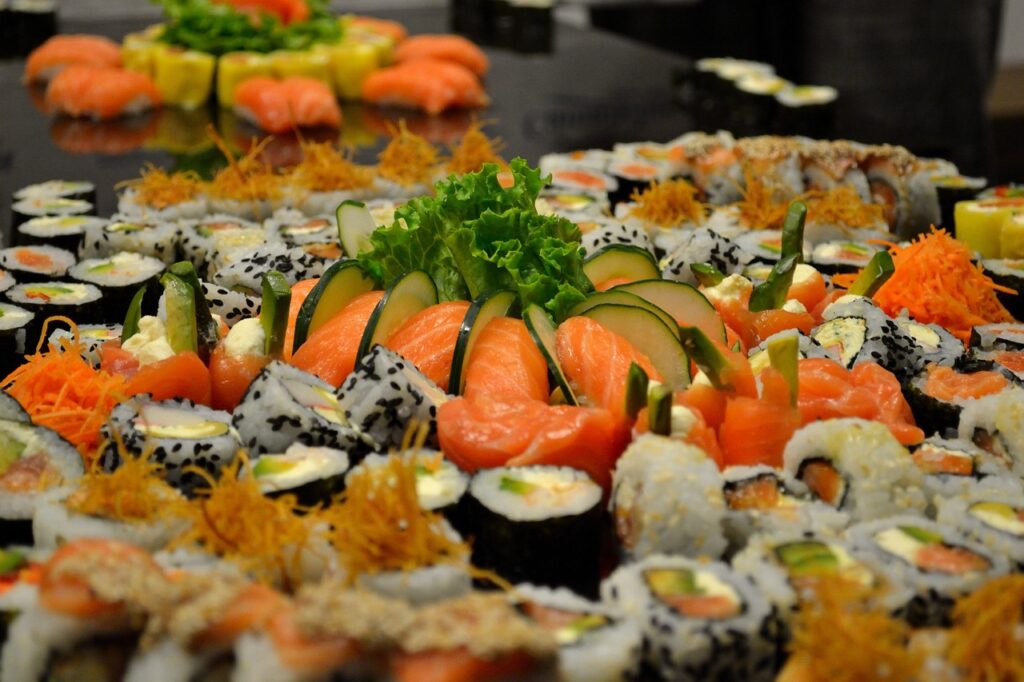From Japanese ramen to sushi, the culinary world is diverse and rich in flavours and unique ingredients. One such important ingredient, often used to make delicious sushi rolls, is Masago. But what exactly is this tiny, orange jewel? In this article, we will unravel the mystery of Masago.
What is Masago?
Masago is edible eggs or roe of the Capelin fish, scientifically known as Mallotus villosus. Capelin fish is a small-sized, cold-water fish found in Atlantic and Arctic oceans. These tiny, crunchy pearls are known for their bright orange colour. It has a sweet and oceanic flavour that makes it a staple in Japanese cuisine, used as a garnish in sushi, sashimi, and other seafood dishes.
What are the types of Masago?
Natural Masago
This is the most common type of Masago, known for its bright orange colour. It is commonly used as a garnish in sushi and other seafood cuisines.
Dyed Masago
Masago is often dyed to enhance its visual appeal. It can be found in vivid orange, red, or green colours. But different colouring doesn’t change the flavour of Masago.
Blue Masago
This type of Masago is taken from male Capelin fish; it is bluish in colour. It’s not used for sushi but can be used as a topping.
Wasabi-Infused Masago
This is a type of Masago that’s been infused with wasabi, a Japanese horseradish. It is used with certain types of sake and light beers, giving it a spicy twist to the conventional Masago flavour.
Difference from Tobiko:
Tobiko is another type of fish roe, a more expensive one, and is also used in sushi. Tobiko is a bit premium roe, it is more crunchy, bigger in size and slightly different in taste from Masago.
Culinary Uses of Masago
Culinary uses of Masago are very diverse and truly impressive. Its texture and unique taste have made it an important ingredient in different cuisines, mostly in the Japanese culture.
It is used as a topping for sushi rolls, giving them a delicious crunch and a pop of colour. Masago is also used in various dips, and sauces, and as a garnish for seafood dishes, elevating the overall flavor profile.
Nutritional value of Masago
Low in calories:
Masago is low in calories itself, so it is a healthy cuisine for those are watching their weights.
10 grams of fish roe contains about 14 calories.
High Protein content:
Masago is full of health benefits as it is an excellent source of protein, which is great for muscle strength and essential for vital biochemical reactions in the body.
10 grams of fish roe contains 2.14 grams of protein.
High Omega 3 content:
Masago is rich in omega 3 fatty acids; specifically, docosahexaenoic acid (DHA) and eicosapentaenoic acid (EPA), aka timnodonic acid in capelin roe has great cardiovascular benefits and also has lesser rheumatoid arthritis incidences; as compared to the other fatty acids. [Source] In short, Omega 3 fatty acids have a great anti-inflammatory role in the body.
10 grams of fish roe contains 0.7 grams of fat.
Vitamins and Minerals:
Masago is enriched with vitamin B12, selenium, iodine, magnesium, and a list of other important nutrients. These nutrients help in cognitive function, the immune system, and thyroid gland function regulation.
High in Sodium:
Masago is relatively high in sodium, packing in about 10% (240 mg) of the daily recommended value (2300 mg) in a single tablespoon. Therefore, those with high blood pressure or heart disease should limit their intake or better consult with their doctor. [Source]
Potential Allergens:
Masago may cause allergic reactions in some individuals, particularly those allergic to fish and & other seafood. Some people may have allergic reactions to fish roe, even if they’re not allergic to other seafood products.
Where to buy Masago?
It can be purchased from online stores, local Asian markets, grocery stores and supermarkets. It can be easily stored in a refrigerator for various months.
Sustainability Concerns
While Masago is a delight for the taste buds, the sustainability concerns associated with capelin fishing are worth noting. As we know that excess of anything is harmful so is the case with capelin fishing. Overfishing has led to a decline in capelin populations and affected the food chain and oceanic ecosystem. After realizing the adversity of the situation, some organizations are trying to save the ecosystem by educating about sustainable fishing practices.
Advice
It’s important to note that the nutritional value of Masago can be offset by additives like added salt, Monosodium glutamate (MSG), or high fructose corn syrup. Therefore, it’s recommended to check product labels carefully when buying Masago products.
Visit our blog section to read more.






